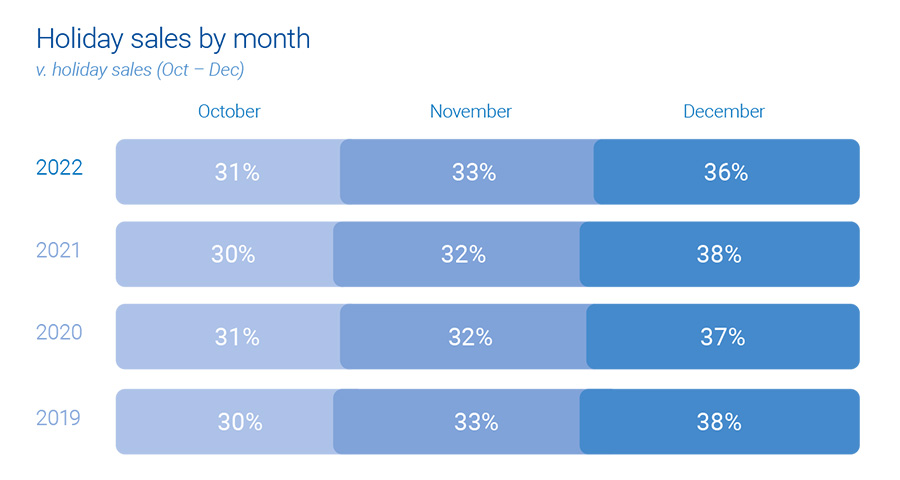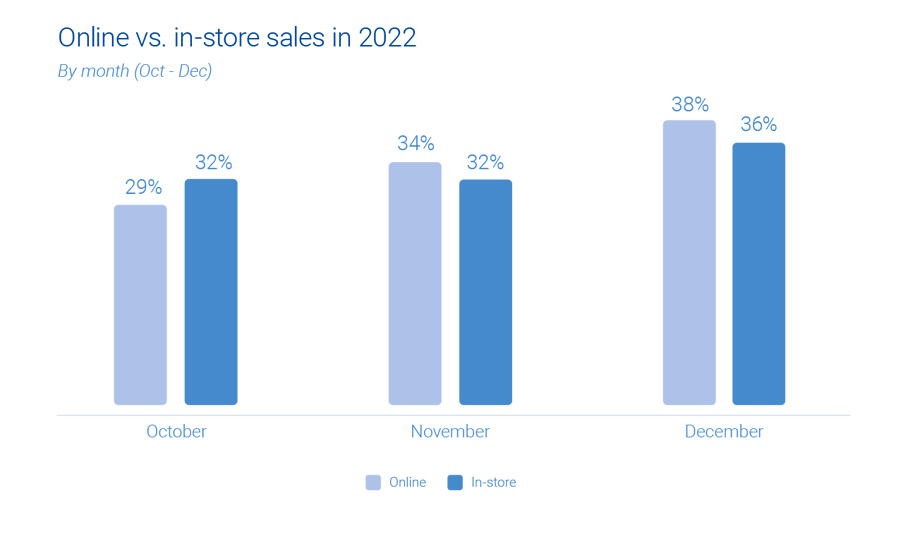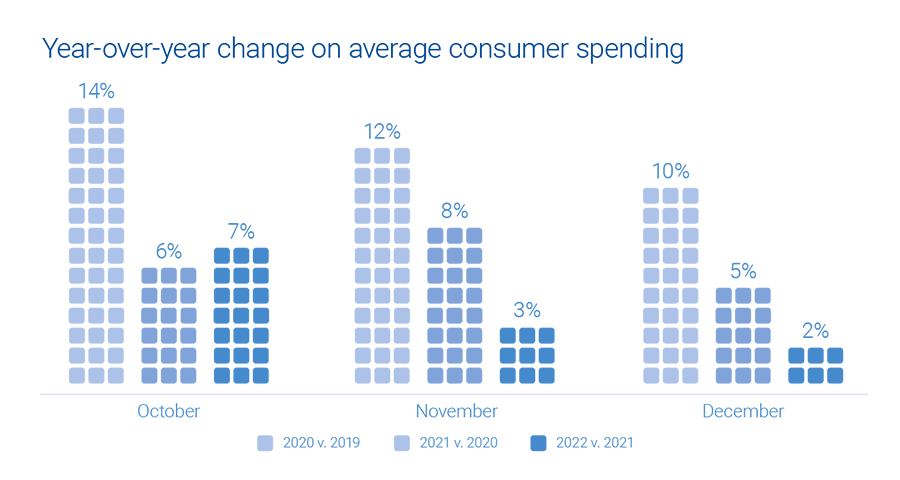
The holiday season is just around the corner, and retailers and marketers are gearing up for the busiest shopping period of the year. It’s crucial to understand how consumer behavior is evolving and what emerging trends to expect. Experian’s 2023 Holiday spending trends and insights report analyzes recent trends, consumer spending habits, and anticipates what’s to come in 2023 to help you deliver a top-notch shopping experience this holiday season.
In this blog post, we’ll cover three key insights from our report.
1. Consumers are shopping earlier
It’s no secret that December has always been the go-to month for consumers when it comes to holiday spending. However, holiday shopping now starts earlier, particularly with online sales.

This can be attributed to a surge in promotions and deals, enticing shoppers to open their wallets ahead of time, giving a significant boost to holiday sales. Notably, Cyber Week sales have proven to be an influential factor, accounting for 8% of total consumer holiday spending.
Experian tip
Reach the right shoppers with your promotions with sell-side targeting. This powerful approach gives you control over where your ads are placed while ensuring maximum visibility through direct connections with publishers. Whether on mobile, web, or CTV, this seamless ad experience will engage your audience effectively.
2. Online sales are on the rise
The popularity of online holiday sales is continuously growing, surpassing in-store shopping. There has been a consistent 1% year-over-year increase in online sales, while in-store sales have seen a 1% decrease.
“It’s easier for consumers to comparison shop for large ticket items online that they might find at a mass retailer or office supply store. Consumers prefer to have larger, bulkier items shipped directly to their home for minimal cost. By shopping online, consumers can save time since they don’t need to wait in checkout lines.”
Anna Liparoto, Sr. Account Executive, Retail & CPG

Although online sales currently make up only one-third of all holiday shopping, there is immense potential for further expansion. Mass retailers and office, electronics, and games industries particularly excel in online holiday sales. While in-store purchases remain the primary choice for holiday shoppers, consumer online and offline activities intersect before the final purchase.
Experian tip
Take advantage of the surge in online shopping by diversifying your marketing channels. An agnostic identity graph can bring together device and media data, capturing valuable user insights. By gaining a holistic view of your target audience, you’ll be able to optimize your ad spend and allocate resources effectively, ultimately boosting your return on investment.
“Omnichannel targeting during the upcoming holiday season will continue to prove to be the best way to reach scale and maximize ROI across all marketing channels.”
Joe LigÉ, Head of Enterprise Demand Partnerships
3. 2023 holiday spending will be on par with 2022
During the holiday season in 2022, consumer spending showed an anticipated increase, although the growth rate was slightly lower compared to previous years. October saw a surge in average consumer spending, indicating a swift response to early discounts and promotions offered by retailers.

As the holiday season progressed, holiday spending gradually slowed down and reached a level similar to that of the previous year. Overall, there was a modest 2% growth. Looking into the future, if economic conditions remain stable in the second half of 2023, we can expect holiday spending to align with the figures from last year.
Experian tip
To truly maximize impact, consider data enrichment. By diving deeper into your target audience’s preferences and behaviors, you can better tailor your strategies and seamlessly integrate the enriched data across various channels. This allows you to unlock the true potential of your ad inventory, creating more meaningful connections with your audience.
Download our 2024 report
Get ready for the holiday shopping season with Experian’s 2024 Holiday spending trends and insights report. Inside you’ll find:
- Analysis of past trends and what they mean for 2024
- Exclusive predictions for the upcoming holiday season
- The top audiences to activate this holiday season
To access to all of our predictions for this year’s holiday shopping season, download our 2024 Holiday spending trends and insights report today.
Latest posts

Oh, how the time flies. We’re already into March of this young 2017, and as much as it pains me to say, it’s probably about time we begin thinking about Holiday 2017. But such is life, and if we have to do it, we might as well do it right. So how do we start to think about “doing it right” in Holiday 2017? Well, as an analytics guy, I might be biased, but I believe the data contains the answers. While there are obviously many more factors, which you can see in our 2016 Holiday Insights webinar, data points and concepts to consider, let’s dive into a few interesting 2016 holiday marketing insights that can help you begin prepping for this upcoming holiday. First, a quick note on the data in this post – all data is collected from a holistic study that examines a single inbox designed to mimic the “average” consumer…and since, on average, most email subscribers aren’t doing more than opening, we make sure that no content is clicked through and no transactions are recorded. We then coded each email on a variety of different metrics, some of which you’ll see below. Finally, in order to increase the robustness of our evaluations, we examine each brand within the study individually, first by calculating the overall average KPIs for the time period within the study. Then, we compare each mailing for each brand against that brand’s baseline, creating a +/- metric on a per campaign basis. Then, we average those metrics across each brand, creating a model for expected performance compared to the “typical” mailing. To illustrate, let’s examine the following (simplified) sample table. Suppose we want to know what the “expected” impact of X for a brand’s marketing program. In the table below, we’ve gathered the open rates for campaigns that exhibit X for brands A & B. The table also shows the long-term average open rates for each brand, and the percent change of the campaigns compared to that baseline. By averaging those results, we get a holistic “expectation model” for campaigns exhibiting X. In this sample, we can generalize to say, any campaign including X for any brand should, on average, expect an open rate that’s about 9% lower than their long-term baseline. Peak week’s heavy influence I don’t think it’s an earth shattering revelation that the data shows peak week’s performance as being significantly above average, but it often surprises me to see just how much better it does than the surrounding time periods. This is easily seen in the chart below, where I’ve plotted every single mailing’s +/- revenue per email over time. I’ve categorized the mailings as “holiday” vs “standard” to see if there were any significant patterns. As you can see, most mailings performed worse than the baseline, due to the baseline being so heavily influenced by peak week, with mailings performing 2-5x better than average. What does it mean? Peak week’s impact is large enough that brands might want to consider viewing it in a vacuum, away from the days surrounding it, in order to get a better read on the overall health of their email program. Your brand should expect much better than average results throughout peak week, of course, and if the data doesn’t show that, you might be in trouble! Holiday messages get a boost with subject line mentions Throughout holiday, creative treatments and copy call out or hint towards specific holidays. Overall, those holiday messages generally perform better than average across all KPIs, as shown below. These results improve even further when those specific holidays are mentioned within the subject line, with Black Friday mailings seeing the largest increase when combined with a subject line mention. What’s most interesting to me, however, is how negatively Christmas themed mailings were affected when the holiday was called out in the subject line (a net 25% decline in revenue per email). All of these results may arise from a case of self-selection bias, whereas we should expect a specific holiday message to do better than average simply because it’s a specific holiday theme. This concept works in a few ways: a) If a company is giving a great offer, they might want to make it feel more “special” by creating a unique theme and selling concept around it (the holiday) . b) If a company has decided to devote resources to creating a mailing designed around a specific holiday, likely requiring a change in the creative process / design or additional strategizing around copy and positioning, then they will likely want to attach stronger offers to make the increased effort worth it. c) Due to the date of deployment, companies are more likely to both add strong offers and devote creative resources to a mailing because they implicitly understand that customers are more likely to engage on those days due to larger economic or societal trends and to differentiate themselves from the noise. d) If companies are devoting good offers or creative treatments to a specific holiday (or both), then the best companies realize that they should signal this with a mention in the subject line, leading any message with a holiday mention to of course do better What does it mean? The data highlights a particularly interesting in holiday email analytics – understanding causal effects. Sure, theming a mailing around a specific holiday might be the cause for the improved metrics, but it’s more likely that we assign holiday themes to a mailing that would have done well already. This is a much larger concept to think about in marketing, and the main takeaway is to be highly critical of any causal inference you make regarding performance. There are bigger factors at play with subject lines than length I have a deep-seated skepticism of any broad subject line analysis – subject lines are a quagmire of entanglements, where no single feature can ever be considered in a vacuum against any other feature. And yet, a tiny bit of Googling reveals hundreds of posts about subject lines, ranging from improving open rates with personalization and emojis to the grand-daddy of them all – shorter subject lines improve open rates. The argument for shorter subject lines in and of itself is an entanglement nightmare, since shortening a subject line can mean creating more clarity and precision to what you’re saying or cutting off back end details that might not be important or making sure relevant data always shows up on mobile. All of these are good ideas, but they are lumped into “shortening subject lines,” despite being fixes for potentially different problems. Oh, and never mind the fact that I’ve never seen any real analysis backing up the broad idea that shorter subject lines create higher “expected” open rates (most don’t normalize the data to try to control for subject line length, and therefore likely read other confounding factors). Our holiday study demonstrates the lack of empirical evidence behind the maxim of “shorter equals better,” showing a wide spread of outcomes at each subject line length and little discernible correlation. Even controlling for longer or shorter subject lines versus the brand’s average shows no real pattern, suggesting that brands that radically increase or reduce their subject lines aren’t expected to see much of a change in open rate performance. What does it mean? Engagement in your mailings is predicated on a much broader combination of relationship building, consistency, and brand value than the subject line – especially its length. Sure, shorter subject lines might force brand’s to be more precise and clear in detailing the mailings contents, but just lopping off words isn’t the most sophisticated path to brand positioning out there, is it? As with any sort of data-driven recap, it can sometimes be difficult to understand what our major takeaways are – after all, shouldn’t we just do what the data says? Not necessarily. The great thing about any “global” recap is that it allows for greater context around your own strategies, ideas, and performance. While the data may suggest particular things (add a specific subject line call out for holiday mailings!), more nuanced thinking might suggest deeper reasons (confounding factors!). That doesn’t mean a recap isn’t important or useful: it just means you – as a brand or strategist or tactician – have to be well informed of what the data says and what it implies. Then you can adapt your strategies accordingly. Of course, if you need some assistance, you can also reach out for help with campaign analysis or marketing strategy. And, as always, happy planning! Interested in more strategic and tactical planning tips? Watch our webinar “Trends are dead ends: Create a clear road to success with our 2017 planning tips” for free!

The volume of email being sent is growing at a rapid pace, that means consumers are wading through hundreds of emails on a daily basis. Combine that with the fact that most consumers spend just a few seconds looking at an email, and you see that marketers need to find better ways to capture and hold audiences’ attention. One answer? Kinetic email. Consumers access their email on a number of devices, including desktop, tablets and smartphones. While marketers have already designed emails to fit the screen of any device their audience uses, kinetic email enables them to develop content that is more interactive and dynamic. Rather than an immediate gateway to the website, consumers can explore the brand’s offerings without leaving their inbox. For example, retail marketers can use carousel navigation to showcase color and size choices within the email. This is not only more convenient for the consumer, but cuts down on the steps to purchase. But how effective is it? In Cross-Channel Marketing’s Q4 2016 Email Benchmark Report, we analyzed seven brands that sent out kinetic emails in 2016, and compared the results to similar non-kinetic mailings sent by the same brands. Based on findings from our report, kinetic emails increased unique click rates by as much as 18.3 percent, and click-to-open rates by more than 10 percent. Other findings included: Email volume increased 14% percent year-over-year, while open, click and transaction rates, revenue per email and average order volumes all remained relatively stable during the same time period. Fifty-six percent of total email opens occurred on mobile phones or tablets in Q4 2016. Revenue per email increased to $0.08 in Q4 2016 compared with $0.06 the previous quarter. But don’t just take the data at face value. Test email campaigns with your own audience to see if kinetic email works for you. Roll out new designs in a staged fashion, from simple to more complex, and measure the performance of campaigns with and without kinetic designs. You can also take it a step further and test based on the type of designs, choice of products, and audience segmentation. Maybe one type of messages works better for a particular audience. At the end of the day, each consumer is unique. There isn’t a one size fits all approach. Marketers can leverage our data and insights to better understand how consumers in specific verticals respond to email, and adjust their marketing campaigns accordingly. Consumer preferences change constantly. It’s the marketers who can adapt and deliver messages that resonate that will stay ahead of the competition. Download a complimentary copy of the email benchmark report and learn more about kinetic emails.

Tapad’s TV analytics solutions now include premium national cable inventory– Travelocity asserts industry need, praises partnership — NEW YORK, February 28, 2017 — Tapad, a part of Experian, has announced its partnership with clypd, the leading audience-based sales platform for television advertising. By integrating clypd’s national cable network inventory, the partnership will expand Tapad’s extensive supply of TV inventory to include premium national cable inventory. Tapad is the leading provider of privacy-safe, cross-screen marketing technology solutions and was first-to-market with a device graph. Clypd’s robust sell-side advertising platform was one of the first built exclusively for the television industry, empowering media owners with solutions that deliver workflow automation, data-enhanced decisioning and, overall, maximize TV campaign performance. Through this partnership, Tapad’s Device Graph-powered TV tools will work in tandem with clypd’s sales platform to enable more precise audience engagement for TV ad buys. This will enable marketers to integrate their customer data or third-party digital segments into Tapad’s TV platform and use them to precisely engage their audience across clypd’s industry-leading footprint of national TV inventory. Campaigns are then optimized using Tapad’s graph-powered TV attribution, ensuring ads are aligned with the best context for each brand’s message. “Clypd is a pioneer in building TV marketplaces,” says Marshall Wong, SVP of TV market development at Tapad. “They were quick to recognize the benefits a device graph could bring to TV so that advertisers can activate linear inventory curated for any digital audience.” “Tapad’s TV activation platform increases the efficiency in which marketers can reach their intended audience on traditional linear TV,” says Doug Hurd, co-founder and EVP of business development at clypd. “Their customized, data-driven campaigns launch with precision and really increase the value marketers can extract from linear TV inventory.” "At Travelocity, we are always looking for ways to more efficiently reach our target audiences,” says Ashley Parker, head of brand marketing at Travelocity. “The combination of traditional linear TV and solutions like this offering from Tapad and clypd are bringing both the tools and the supply to make this vision a reality." Contact us today!